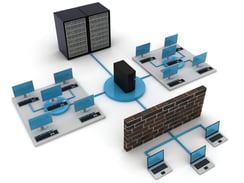
Sponsored by Intel
What is Intel GVT, and how can it help speed up the design process?
By Robert Green
![]() In the first installment of Server-Hosted Workstations for CAD we introduced the concept of using Intel Graphics Virtualization Technology (GVT) combined with Citrix XenDesktop and HDX 3D Pro software to virtualize CAD applications to remote users from servers in your data center.
In the first installment of Server-Hosted Workstations for CAD we introduced the concept of using Intel Graphics Virtualization Technology (GVT) combined with Citrix XenDesktop and HDX 3D Pro software to virtualize CAD applications to remote users from servers in your data center.
To explore GVT solutions for your company, you must complete several phases of investigation and discovery — with user experience and perception of the remote workstation as a high priority. User perception is key to making any changes in your computing environment, so in this part of our series we’ll focus on the core issues surrounding user interaction with and response to workstation virtualization.
Peripherals and Interface
If you tell a CAD user they will connect to a remote workstation, they’ll immediately want to know if it will affect their day-to-day operations. They’ll have questions about peripherals, screen layout, and how the connection will “feel,” as compared to their normal CAD desktop. Of particular importance to consider are the following:
 |
©iStockPhoto.com/alexsi |
As long as the hardware devices used are supported and configured on the remote workstation, most CAD users won’t notice a difference when using a remote connection.
Graphics Power
CAD users utilize a high degree of visualization techniques such as shading, rendering, and 3D rotation as they create 3D models. Even less intensive applications such as AutoCAD can now read 3D data or point clouds from other software tools, thus requiring real graphics power.
GVT-based remote workstations provide ample power via Intel Iris Pro Graphics, rated at 48 graphics Execution Units and up to 128 MB of on-package eDRAM — putting them on par with midrange graphics processors that cost several hundred dollars. After processing at the remote workstation, the user receives the graphical results at the desktop via Citrix HDX 3D Pro’s compressed video format that speeds results and minimizes network bandwidth consumption, according to Citrix.
For all but the most power hungry graphic uses, the Iris Pro graphics processor with HDX 3D Pro graphics should provide a “like you are there” user experience.
Performance Lag (Latency)
The concept of network latency often comes up when talking about remote-hosted applications. Put simply, latency is the delay between a user action (like clicking the mouse) and seeing the result of the action. In cases of low latency, the user doesn’t perceive much of a delay — at least not enough to be annoying. But as latency increases, the delay becomes noticeable and CAD users will voice a very negative impression of the slower application response.
To predict the effects of latency in your network, consider these industry standard strategies:
So while GVT remote workstations and Citrix applications can handle CAD applications and graphics with ease, it will be your decisions on how far away your users are from your data center and how they are configured that determine the degree of performance lag they experience. And, in the world of CAD users, the less performance lags the better.
CAD Meets IT Planning
It's crucial to keep in mind with GVT-based remote workstations is that their ability to serve you well is heavily reliant on your network. For this reason, your IT department must be involved with specifying any GVT-based system. Plus, the remote workstation hardware will be housed in an IT data center maintenance and support for both the hardware and CAD software installed on it will become an IT-driven function.
In upcoming installments we'll examine which software applications are certified to run on GVT remote workstations, some of the nuts and bolts of administering them, and the economic advantages of centralization that your IT department will need to understand. Until next time.
Robert Green performs CAD programming and consulting throughout the United States and Canada. He is the author of Expert CAD Management: The Complete Guide. Reach him via his web site, www.cad-manager.com.









